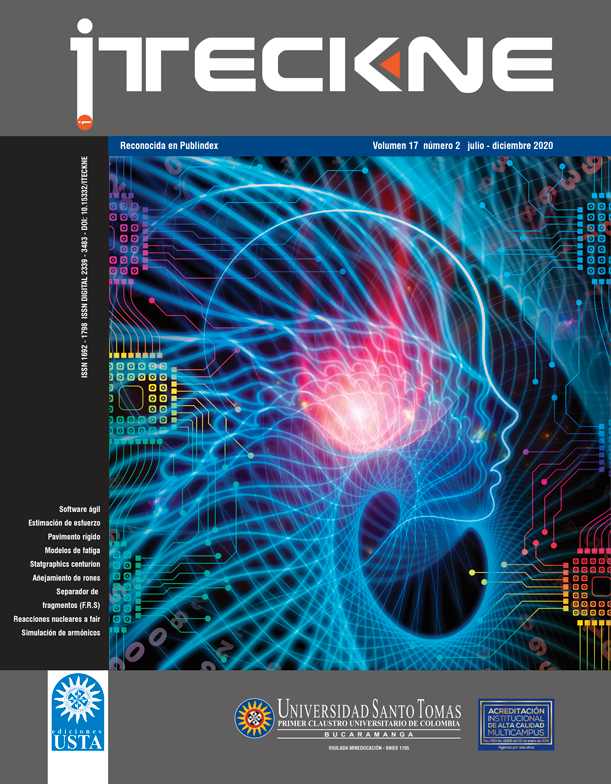Métodos de Simulación de Armónicos en Sistemas Eléctricos de Potencia
DOI:
https://doi.org/10.15332/iteckne.v17i2.2466Palabras clave:
Simulación de armónicos, Métodos de simulación de armónicos, elementos no linealesResumen
La simulación de armónicos en sistemas de potencia puede realizarse mediante métodos que empleen la dependencia temporal o la dependencia frecuencial de los sistemas eléctricos. Todos los métodos detallados requieren de la solución de las ecuaciones de la red, y es en la forma de estas ecuaciones que los métodos se diferencian. La robustez y rápida convergencia hacen que unos métodos sean más empleados porque pueden entregar resultados más precisos. Los diversos componentes de la red deben ser modelados apropiadamente para que puedan reflejar su comportamiento cuando las variables de estado del sistema tienen a tomar formas altamente distorsionadas y para esto se deben tomar los modelos que se detallan en la literatura. Una vez que se realizan simulaciones de armónicos, se deben comparar los resultados obtenidos con aquellos límites que figuran en normativas específicas de calidad de energía y, en caso de ser excesiva la emisión el paso a seguir es el diseño de estrategias o sistemas de mitigación de armónicos.
Descargas
Citas
[2] A. Valenzuela, I. Montalvo, and C. Barrera-singaña, “Electrical Vehicle: Facing Future Challenges in Quito,” 2017, doi: <a href="https://doi.org/10.1109/ISGT-LA.2017.8126694" target= _blank> https://doi.org/10.1109/ISGT-LA.2017.8126694 </a>
[3] A. Valenzuela, C. Barrera, and E. Inga, “Electrical assessment of georeferenced distribution network due to electric vehicles deployment Evaluación de un sistema eléctrico georreferenciado de distribución debido a la penetración de vehículos eléctricos,” Rev. I+D tecnológico, vol. 16, no. 1, 2020.
[4] J. M. Soni and M. H. Pandya, “Power Quality Enhancement for PV rooftop and BESS in Islanded mode,” Proc. 4th Int. Conf. Electr. Energy Syst. ICEES 2018, pp. 242-247, 2018, doi: <a href="https://doi.org/10.1109/ICEES.2018.8442370" target= _blank> https://doi.org/10.1109/ICEES.2018.8442370 </a>
[5] C. A. Caldeira, A. D. D. De Almeida, H. R. Schlickmann, C. S. Gehrke, and F. Salvadori, “Impact analysis of the BESS insertion in electric grid using real-time simulation,” 2019 IEEE PES Conf. Innov. Smart Grid Technol. ISGT Lat. Am. 2019, pp. 1-6, 2019, doi: <a href="https://doi.org/10.1109/ISGT-LA.2019.8895464" target= _blank> https://doi.org/10.1109/ISGT-LA.2019.8895464 </a>
[6] C. Burgos-Mellado et al., “Distributed Control Strategy Based on a Consensus Algorithm and on the Conservative Power Theory for Imbalance and Harmonic Sharing in 4-Wire Microgrids,” IEEE Trans. Smart Grid, vol. 11, no. 2, pp. 1-1, 2019, doi: <a href="https://doi.org/10.1109/tsg.2019.2941117" target= _blank> https://doi.org/10.1109/tsg.2019.2941117 </a>
[7] F. Nejabatkhah, Y. W. Li, and H. Tian, “Power quality control of smart hybrid AC/DC microgrids: An overview,” , vol. 7, pp. 52295-52318, 2019, doi: <a href="https://doi.org/10.1109/ACCESS.2019.2912376" target= _blank> https://doi.org/10.1109/ACCESS.2019.2912376 </a>
[8] S. Li et al., “Effect of AC-voltage harmonics on oil impregnated paper in transformer bushings,” IEEE Trans. Dielectr. Electr. Insul., vol. 27, no. 1, pp. 26-32, 2020, doi: <a href="https://doi.org/10.1109/TDEI.2019.008247" target= _blank> https://doi.org/10.1109/TDEI.2019.008247 </a>
[9] S. B. Subramanian, R. K. Varma, and T. Vanderheide, “Impact of Grid Voltage Feed-Forward Filters on Coupling between DC-Link Voltage and AC Voltage Controllers in Smart PV Solar Systems,” IEEE Trans. Sustain. Energy, vol. 11, no. 1, pp. 381-390, 2020, doi: <a href="https://doi.org/10.1109/TSTE.2019.2891571" target= _blank> https://doi.org/10.1109/TSTE.2019.2891571 </a>
[10] T. L. G. Soh, D. M. Said, N. Ahmad, K. M. Nor, and F. Salim, “Experimental study on the impact of harmonics on transformer,” Proc. 2013 IEEE 7th Int. Power Eng. Optim. Conf. PEOCO 2013, no. June, pp. 686-690, 2013, doi: <a href="https://doi.org/10.1109/PEOCO.2013.6564634" target= _blank> https://doi.org/10.1109/PEOCO.2013.6564634 </a>
[11] J. Kaiwart and U. Bala, “Techniques for Power Quality Improvement by Mitigation of Harmonics,” Int. Conf. Energy, Commun. Data Anal. Soft Comput., no. 1, pp. 1532-1536, 2017.
[12] A. Medina et al., “Harmonic analysis in frequency and time domain,” IEEE Trans. Power Deliv., vol. 28, no. 3, pp. 1813-1821, 2013, doi: <a href="https://doi.org/10.1109/TPWRD.2013.2258688" target= _blank> https://doi.org/10.1109/TPWRD.2013.2258688 </a>
[13] IEEE Task Force on Harmonic Modeling and Simulation, “Modeling and simulation of the propagation of harmonics in electric power systems Part II: Sample systems and examples,” 1996.
[14] W. Su, Z. Li, and Z. Shao, “The harmonic calculation model of non-linear load,” China Int. Conf. Electr. Distrib. CICED, vol. 2014-Decem, no. Ciced, pp. 866-872, 2014, doi: <a href="https://doi.org/10.1109/CICED.2014.6991832" target= _blank> https://doi.org/10.1109/CICED.2014.6991832 </a>
[15] J. E. Caicedo, A. A. Romero, and H. C. Zini, “Frequency domain modeling of nonlinear loads, considering harmonic interaction,” 2017 3rd IEEE Work. Power Electron. Power Qual. Appl. PEPQA 2017 - Proc., pp. 1-6, 2017, doi: <a href="https://doi.org/10.1109/PEPQA.2017.7981641" target= _blank> https://doi.org/10.1109/PEPQA.2017.7981641 </a>
[16] G. Constante, “Flujo de potencia de armónicos utilizando Matlab,” Quito : EPN, 2014., Sep. 2014.
[17] J. Arrillaga, A. Medina, M. L. V. Lisboa, P. Sánchez, and M. A. Cavia, “The harmonic domain. A frame of reference for power system harmonic analysis,” IEEE Trans. Power Syst., vol. 10, no. 1, pp. 433-440, 1995, doi: <a href="https://doi.org/10.1109/59.373968" target= _blank> https://doi.org/10.1109/59.373968 </a>
[18] A. Semlyen and A. Medina, “Computation of the periodic steady state in systems with nonlinear components using a hybrid time and frequency domain methodology,” IEEE Trans. Power Syst., vol. 10, no. 3, pp. 1498-1504, 1995, doi: <a href="https://doi.org/10.1109/59.466497" target= _blank> https://doi.org/10.1109/59.466497 </a>
[19] IEC, “IEC, 61000-3-6 Electromagnetic Compatibility (EMC) - Part 3: Limits - Section 6: Assessment of emisión limits for distorting loads in MV and HV power systems - Basic EMC publication.” 1996.
[20] IEC, “IEC, 61400-21 Wind turbines - Part 21: Measurement and assessment of power quality characteristics of grid connected wind turbines.” 2008.
[21] S. A. Papathanassiou and M. P. Papadopoulos, “Harmonic analysis in a power system with wind generation,” IEEE Trans. Power Deliv., vol. 21, no. 4, pp. 2006-2016, Oct.2006, doi: <a href="https://doi.org/10.1109/TPWRD.2005.864063" target= _blank> https://doi.org/10.1109/TPWRD.2005.864063 </a>
Descargas
Publicado
Cómo citar
Número
Sección
Licencia
La revista ITECKNE se encuentra registrada bajo una licencia de Creative Commons Reconocimiento-NoComercial 4.0 Internacional Por lo tanto, esta obra se puede reproducir, distribuir y comunicar públicamente, siempre que se reconozca el nombre de los autores y a la Universidad Santo Tomás. Se permite citar, adaptar, transformar, autoarchivar, republicar y crear a partir del material, siempre que se reconozca adecuadamente la autoría, se proporcione un enlace a la obra original y se indique si se han realizado cambios.
La Revista ITECKNE no retiene los derechos sobre las obras publicadas y los contenidos son responsabilidad exclusiva de los autores, quienes conservan sus derechos morales, intelectuales, de privacidad y publicidad. Sin embargo esta facultada para editar, publicar, reproducir y distribuir tanto en medios impresos como digitales, además de incluir el artículo en índices internacionales y/o bases de datos, de igual manera, se faculta a la editorial para utilizar las imágenes, tablas y/o cualquier material gráfico presentado en el artículo para el diseño de carátulas o posters de la misma revista.













